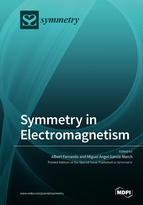Symmetry in Electromagnetism
A special issue of Symmetry (ISSN 2073-8994). This special issue belongs to the section "Physics".
Deadline for manuscript submissions: closed (31 October 2019) | Viewed by 45623
Special Issue Editors
Interests: electromagnetic propagation in optical waveguides; fiber devices; microwave waveguides; cavities
Interests: expertise in quantum optics; atomic physics; nonlinear dynamics; statistical physics; quantum field theory; many body systems; disordered systems; neural networks; quantum information; foundations of quantum mechanics
Special Issues, Collections and Topics in MDPI journals
Special Issue Information
Dear Collegues,
Electromagnetism plays an essential role, both in basic and applied physics research. The discovery of electromagnetism as the unifying theory for electricity and magnetism represented a cornerstone in modern physics. From the very beginning, symmetry was crucial to the concept of unification: Electromagnetism was soon formulated as a gauge theory, in which a local phase symmetry explained its mathematical formulation. This early connection between symmetry and electromagnetism shows that a symmetry approach to many electromagnetic phenomena is recurrent, even today.
Moreover, many crucial technological advances associated with electromagnetism have shaped modern civilization. The control of electromagnetic radiation in nearly all its spectra and scales is still a matter of deep interest. With the advances in material science, even at the nanoscale, the manipulation of matter–radiation interactions has reached unprecedented levels of sophistication. New generations of composite materials present effective electromagnetic properties that permit to mold electromagnetic radiation in ways that were unconceivable just a few years ago. This is a fertile field for applications and for basic understanding in which symmetry, as in the past, bridges apparently-unrelated phenomena, from condensed matter to high-energy physics.
In this Special Issue we want to pay attention to this modern view on electromagnetism, which represents both an arena for academic advance and exciting applications. This Special Issue will include contributions on electromagnetic phenomena, in which symmetry plays a significant role, such as (though not restricted to): Phase phenomena and its management (e.g., knots of light or in singular optics); dual electromagnetism; PT-symmetry; mode classification in electromagnetic devices; photonic condensed matter (including topological photonics, synthetic gauge fields and spin-orbit effects in electromagnetism); quantum aspects of electromagnetic waves from a symmetry perspective (symmetry entanglement in optics); etc.
Prof. Dr. Albert Ferrando
Dr. Miguel Ángel García-March
Guest Editors
Manuscript Submission Information
Manuscripts should be submitted online at www.mdpi.com by registering and logging in to this website. Once you are registered, click here to go to the submission form. Manuscripts can be submitted until the deadline. All submissions that pass pre-check are peer-reviewed. Accepted papers will be published continuously in the journal (as soon as accepted) and will be listed together on the special issue website. Research articles, review articles as well as short communications are invited. For planned papers, a title and short abstract (about 100 words) can be sent to the Editorial Office for announcement on this website.
Submitted manuscripts should not have been published previously, nor be under consideration for publication elsewhere (except conference proceedings papers). All manuscripts are thoroughly refereed through a single-blind peer-review process. A guide for authors and other relevant information for submission of manuscripts is available on the Instructions for Authors page. Symmetry is an international peer-reviewed open access monthly journal published by MDPI.
Please visit the Instructions for Authors page before submitting a manuscript. The Article Processing Charge (APC) for publication in this open access journal is 2400 CHF (Swiss Francs). Submitted papers should be well formatted and use good English. Authors may use MDPI's English editing service prior to publication or during author revisions.
Keywords
- Topological photonics
- Synthetic gauge fields in EM
- Duality in EM
- PT-symmetry in EM
- Knots in EM
- Symmetry and EM devices. Mode classification
- Spin-Orbit effects in EM
- Symmetry in complex light/singular optics
- Symmetry in EM metamaterials
- Symmetry entanglement in optics






